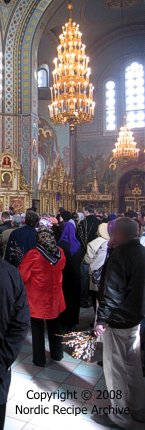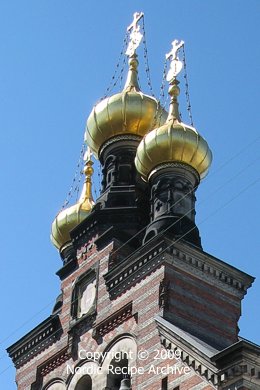 The ecclesiastical year in the Orthodox Christian Church begins on September 1st. Easter is the most important festival of the year in the Orthodox church. It is celebrated right until the Ascension Day (Christ's ascension into Heaven) which is due forty days after Easter.
The ecclesiastical year in the Orthodox Christian Church begins on September 1st. Easter is the most important festival of the year in the Orthodox church. It is celebrated right until the Ascension Day (Christ's ascension into Heaven) which is due forty days after Easter.
In the church services of Orthodox churches, the Easter time events in the life of Jesus are reconstructed by performing different
acts symbolizing these events. The great midnight service between Saturday and Easter Sunday is the most popular event in the Orthodox church. On Easter Sunday people celebrate together by having Easter dinner with their family.
In picture above: The Uspenski cathedral in Helsinki — the largest Orthodox cathedral in Western Europe.
From Shrovetide to Holy Week
The preparing for Orthodox Easter begins with Great Lent, a fast lasting for 40 days. At this time, one should only eat fish and vegetable
dishes and abstain from eating meat, eggs and dairy products.
Great Lent begins on Shrove Monday, at Shrovetide (which usually falls in February) and ends on the Friday before the start of Holy Week, although the fasting will still continue through the Holy Week up until the Easter Sunday. Sundays are excluded from the counting of fast days.
Note: click on the following links to read more about Shrovetide and see traditional Finnish Shrovetide recipes.
|
Holy Week |
| Lazarus Saturday |
Palm Sunday |
Monday |
Tuesday |
Wednesday |
Maundy Thursday |
Good Friday |
Holy Saturday |
Easter Sunday |
 Easter week, or Holy Week, begins with Palm Sunday, which is celebrated to commemorate the festal arrival
of Jesus to Jerusalem.
Easter week, or Holy Week, begins with Palm Sunday, which is celebrated to commemorate the festal arrival
of Jesus to Jerusalem.
During the Palm Sunday church service, the priest will bless palm leaves or olive tree twigs, which are regarded as symbols of victory, peace and anointment.
In northern countries, like Finland and northern Russia, where palms or olive trees do not grow, they are replaced with pussy willow twigs. These are handed out to the parishioners after the service.
The twigs are brought home where they may be decorated with colourful feathers and other Easter ornaments.
Picture on right: parishioners holding pussy willow twigs during a Palm Sunday church service in the Nativity of Christ Cathedral in Riga, Latvia.
 On Palm Sunday, the children of Orthodox families have a custom of going from door to door to wish their relatives and neighbours God's blessing by whisking at them with the blessed willow twigs, called virpovitsa in Finnish.
On Palm Sunday, the children of Orthodox families have a custom of going from door to door to wish their relatives and neighbours God's blessing by whisking at them with the blessed willow twigs, called virpovitsa in Finnish.
Picture on left: pussy willow twigs decorated with colourful feathers.
In the church services of the following Monday, Tuesday and Wednesday, the Gospel readings already anticipate the sufferings of Christ. They prepare the parishioners for the coming event of Easter by bringing forward and helping to understand the various elements that are important for man's salvation, strengthening one's spirit and faith.
In Maundy Thursday church service, after the Holy Communion, a bishop washes the feet of twelve priests, like Jesus washed the feet of his disciples after the last supper.
 Good Friday is a day of silent sorrow, devoted to the memory of the crucifixion of Jesus. After the Gospel reading, the "body of Christ is removed from the cross" by carrying the shroud of Christ
(a cloth on which the body of Christ is pictured) in a cross-procession to the centre of the church where the parishioners go and kiss the wounds on his hands and feet. The priests are clad in black in sign of sorrow.
Good Friday is a day of silent sorrow, devoted to the memory of the crucifixion of Jesus. After the Gospel reading, the "body of Christ is removed from the cross" by carrying the shroud of Christ
(a cloth on which the body of Christ is pictured) in a cross-procession to the centre of the church where the parishioners go and kiss the wounds on his hands and feet. The priests are clad in black in sign of sorrow.
On Holy Saturday, an act of burying Jesus is performed, and his descending into Hades to free the dead during his entombment is remembered, among other things. The church prepares the parishioners to receive the message of Christ's resurrection.
During the service, the priests change their black vestments into white to mark the overcome of life from death.
 The Holy Saturday evening service culminates in the midnight service after which, on Easter Sunday, Jesus "rises from the dead".
The service begins in darkness, with everyone inside the church holding an unlit candle. The priest then lights his candle from the altar flame and passes the light to the candle of the next person, who will pass it on to the next, until all the candles are lit and the church is glowing with light.
The Holy Saturday evening service culminates in the midnight service after which, on Easter Sunday, Jesus "rises from the dead".
The service begins in darkness, with everyone inside the church holding an unlit candle. The priest then lights his candle from the altar flame and passes the light to the candle of the next person, who will pass it on to the next, until all the candles are lit and the church is glowing with light.
Picture above: a bunch of pussy willow twigs.
 After this, the priest leads a cross-procession out of the church and around it, with the congregation following him. This is done to commemorate the journey of the myrrh-bearing women, the followers of Jesus who came to his tomb and found it empty.
After this, the priest leads a cross-procession out of the church and around it, with the congregation following him. This is done to commemorate the journey of the myrrh-bearing women, the followers of Jesus who came to his tomb and found it empty.
The procession stops in front of the closed church doors and the hymn of resurrection is sung: "Christ is risen from the dead, and by his death he has trampled upon death and has given life to those who are in the tombs."
Picture on right: the golden domes of the Orthodox Alexander Nevsky Kirke in Copenhagen, Denmark.
The "tomb is found empty", the bells are ringing, the church is filled with light and the service takes on a joyous Easter atmosphere.
People greet one another by kissing each other three times on the cheeks, saying: "Christ is risen!" which is answered: "indeed he is!".
